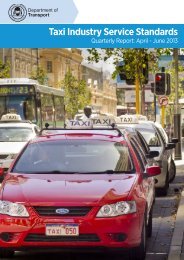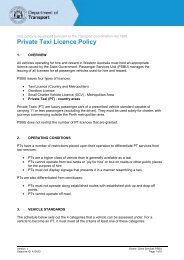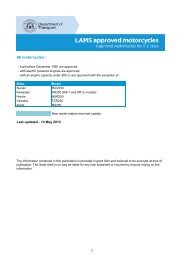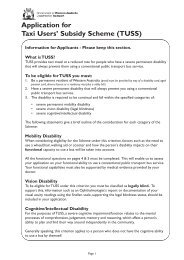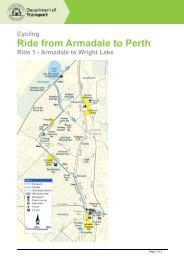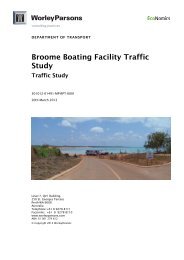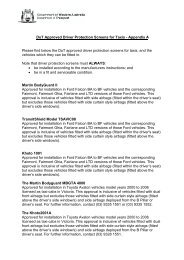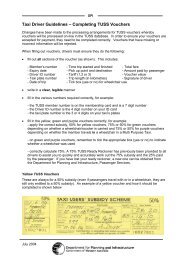Department of Transport Annual Report 2010 - 2011
Department of Transport Annual Report 2010 - 2011
Department of Transport Annual Report 2010 - 2011
Create successful ePaper yourself
Turn your PDF publications into a flip-book with our unique Google optimized e-Paper software.
Key performance indicators<br />
Certification <strong>of</strong> key performance indicators<br />
For the year ended 30 June <strong>2011</strong><br />
I hereby certify that the performance indicators are based on proper records, are<br />
relevant and appropriate for assisting users to assess the DoT’s performance and<br />
fairly represent the performance <strong>of</strong> the DoT for the financial year ended 30 June <strong>2011</strong><br />
Reece Waldock<br />
Accountable Authority<br />
94<br />
Key performance indicators<br />
The transport function is integral to business and commerce, and important for<br />
social interaction and connecting communities. DoT’s key focus is on strategic<br />
transport policy and planning, regulation, and operational transport functions<br />
across the range <strong>of</strong> public and commercial transport systems that service Western<br />
Australia. With more than 1200 employees, and together with its portfolio partners,<br />
DoT has the expertise to deliver high quality and integrated transport policy and<br />
plans that connect a complex, inter-related economic and social network. DoT<br />
connects people with goods and services through an intricate system <strong>of</strong> roads,<br />
railways, airports, ports and waterways, and educates and regulates to keep people<br />
safe within those networks.<br />
DoT’s outcome structure was changed for the <strong>2010</strong>-11 financial year to address the<br />
final split <strong>of</strong> the DPI into three new departments, including DoT. New key performance<br />
indicators (KPIs) will better align to the DoT outcomes by providing more relevant<br />
assessments, such as accessibility to taxis through measuring the taxi jobs not<br />
covered and the percentage <strong>of</strong> times acceptable industry waiting times are met.<br />
KPIs that are no longer considered relevant to DoT business have been removed.<br />
The breadth and diversity <strong>of</strong> DoT’s functions and services means that DoT contributes<br />
to many <strong>of</strong> the Government’s strategic goals, with the most significant contributions<br />
outlined below.<br />
Government strategic goals<br />
Outcome based service delivery<br />
Greater focus on achieving<br />
results in key service delivery<br />
areas for the benefit <strong>of</strong> all<br />
Western Australians.<br />
State building – Major projects<br />
Building strategic infrastructure<br />
that will create jobs and underpin<br />
Western Australia’s long-term<br />
economic development.<br />
<strong>Department</strong>al desired<br />
outcomes<br />
1. An accessible and safe<br />
transport system<br />
2. Vehicles and road users<br />
that meet established<br />
vehicle standards and<br />
driver competencies.<br />
3. Integrated transport<br />
systems that facilitate<br />
economic development.<br />
<strong>Department</strong>al services<br />
1. <strong>Transport</strong> system and<br />
services development,<br />
planning, operation and<br />
regulation.<br />
2. Motor vehicle and driver<br />
licensing services.<br />
3. Strategic transport policy.<br />
4. Integrated transport<br />
planning.



